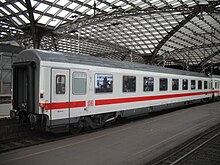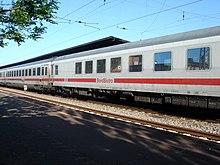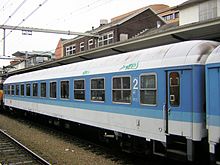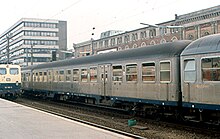
A railroad car, railcar, railway wagon, railway carriage, railway truck, railwagon, railcarriage or railtruck, also called a train car, train wagon, train carriage or train truck, is a vehicle used for the carrying of cargo or passengers on a rail transport system. Such cars, when coupled together and hauled by one or more locomotives, form a train. Alternatively, some passenger cars are self-propelled in which case they may be either single railcars or make up multiple units.

Slovenian Railways is the state railway company of Slovenia, created in 1991.
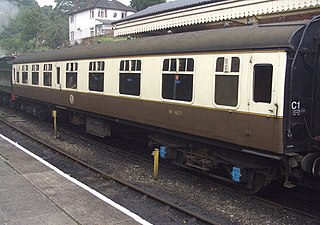
The Composite Corridor is a railway coach with a number of compartments, some of which are standard class and some first class, linked by a side corridor.
Push–pull is a configuration for locomotive-hauled trains, allowing them to be driven from either end of the train, whether having a locomotive at each end or not.

The Baureihe E 40 is a German Standard electric locomotive commissioned by the Deutsche Bundesbahn in 1955, designed for freight trains. Since the 1968 renumbering, it is listed as Class 140 and Class 139.
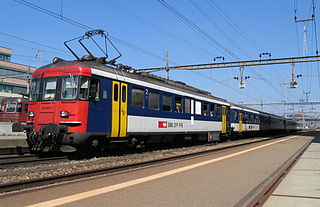
Starting in 1959, the SBB motor coach of the type RBe 4/4 was for a replacement of the old SBB electric locomotives Ae 3/6 I, Ae 3/6 II, Ae 3/6 III and SBB Ae 3/5 with three driving axles. As a consequence, they had much power at their disposal, even more than the Re 4/4 I locomotives, a regenerative brake, cabs on both ends with doors to passenger carriages as well as Multiple-unit train control SBB Vst IIId for multiple-unit or driving trailer. They originally motor coach had 64 seats, 32 smoking and 32 non-smoking, and were painted in ordinary SBB green.
City Night Line, abbreviated CNL, was a train category of German railway company Deutsche Bahn for overnight passenger train services between Germany and neighbouring European countries. In late 2015, Deutsche Bahn announced that it planned to terminate all night train services in December 2016, and this plan was implemented on 11 December 2016. The service on some CNL routes was replaced by ÖBB Nightjet services.
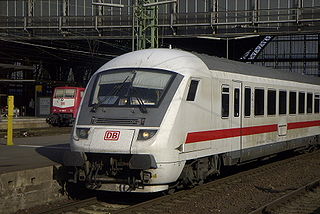
A control car, cab car, control trailer, or driving trailer is a non-powered rail vehicle from which a train can be operated. As dedicated vehicles or regular passenger cars, they have one or two driver compartments with all the controls and gauges required to remotely operate the locomotive, including exterior locomotive equipment such as horns, bells, ploughs, and lights. They also have communications and safety systems such as GSM-R or European Train Control System (ETCS). Control cars enable push-pull operation when located on the end of a train opposite its locomotive by allowing the train to reverse direction at a terminus without moving the locomotive or turning the train around.

The Re 620, Re 6/6 in the old numbering scheme, are six-axle, electric locomotives of the SBB-CFF-FFS, which were acquired as a replacement for the Ae 6/6 for heavy services on the Gotthardbahn. They are the most modern of the so-called "Gotthard locomotives".
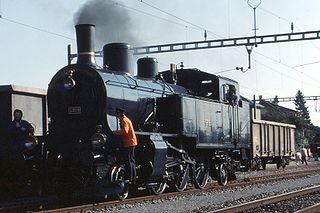
For more than a century, the Swiss locomotive, multiple unit, motor coach and railcar classification system, in either its original or updated forms, has been used to name and classify the rolling stock operated on the railways of Switzerland. It started out as a uniform system for the classification and naming of all rolling stock, powered and unpowered, but had been replaced and amended by the UIC classification of goods wagons.
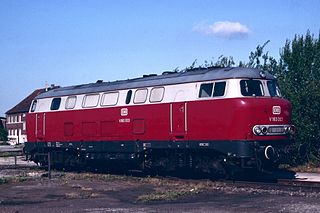
The Class V 160 is a class of diesel-hydraulic locomotives of the German railways. It is the first variant of the V160 family, built for the Deutsche Bundesbahn for medium/heavy trains.

The Umbau-Wagen or Umbauwagen was a type of German railway passenger coach operated by the Deutsche Bundesbahn (DB) which appeared in the mid-1950s. The name means "rebuild coach" and they were made by rebuilding or converting former state railway (Länderbahn) compartment coaches, many of which were over 30 years old.
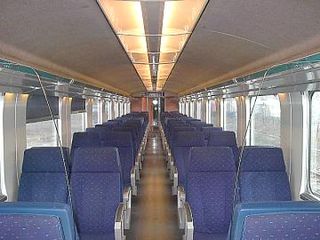
An open coach is a railway passenger coach that does not have compartments or other divisions within it and in which the seats are arranged in one or more open plan areas with a centre aisle. The first open coaches appeared in the first half of the 19th century in the United States. The prototype for their design were the passenger cabins in the river steamers which were then widespread in America. As a result of their origin they were originally known in Europe as American system passenger coaches or American coaches and the idea soon caught on in European railway companies. Initially they were mainly used for rural regional services, whilst urban local trains and local-distance services were dominated by compartment coaches. Several European railways such as the Royal Württemberg State Railways and the Swiss Northeastern Railway, however, preferred open coaches from the start for all types of train.

A compartment coach is a railway passenger coach divided into separate areas or compartments, with no means of moving between compartments.
The Eilzugwagen was a type of railway passenger coach specially developed for German semi-fast trains, known as Eilzüge. These coaches were first built in the 1930s and continued to be produced until the 1950s. Today all coaches of this type have been retired. A number still run on museum railways.
The UIC type X, Y and Z coaches are passenger coaches for international railway services that have been standardised in certain respects by the International Union of Railways.

The Córas Iompair Éireann (CIÉ) 2600 Class were Associated Equipment Company (AEC)–engined diesel multiple units that operated InterCity and suburban services on the CIÉ system between 1952 and 1975. Many were later converted for push–pull operation with diesel locomotives, finally being withdrawn when displaced by the electric Dublin Area Rapid Transit service in the mid-1980s.

The Furka Oberalp Bahn Deh 4/4 I, now known as the Matterhorn Gotthard Bahn Deh 4/4 51–55, is a five member class of metre gauge, rack rail, electric multiple units operated until 2002 by the Furka Oberalp Bahn (FO), and since then by its successor, the Matterhorn Gotthard Bahn (MGB), in the Canton of Valais, Switzerland.

The Brig-Visp-Zermatt-Bahn Deh 4/4, now known as the Matterhorn Gotthard Bahn Deh 4/4 21–24, is a four member class of metre gauge, rack rail, electric multiple unit power cars operated until 2002 by the Brig-Visp-Zermatt-Bahn (BVZ), and since then by its successor, the Matterhorn Gotthard Bahn (MGB), in the Canton of Valais, Switzerland.

The Linke-Hofmann-Busch local traffic prototype coaches were a group of passenger carriages of the Deutsche Bundesbahn.
